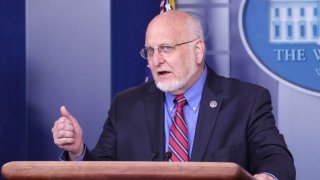
U.S. health officials removed some coronavirus reopening tips for religious organizations only hours after posting them late last week, deleting guidance that discouraged choir gatherings and the use of shared communion cups.
A federal health official on Friday said the Centers for Disease Control and Prevention posted a version of the guidance on May 22 that had not been cleared by White House officials. It was replaced the next day, said the official, who was not authorized to discuss the matter and spoke to The Associated Press on condition of anonymity.
The initial guidance posted last week contained most of the same advice that was in a draft drawn up by the CDC more than a month ago and then shelved for weeks by administration officials. The guidance suggested people in churches use face coverings, stay 6 feet apart, avoid use of shared cups and dishes, and cut down singing to reduce the chance of spreading the virus.
Earlier this month, the CDC published a report that concluded a choir practice in Washington state was a “superspreader” event that infected 52 people, including two who died. Skagit County Public Health investigators believe the act of singing itself may have spread the coronavirus in the air and onto surfaces.
Get a weekly recap of the latest San Francisco Bay Area housing news. Sign up for NBC Bay Area’s Housing Deconstructed newsletter.
The CDC’s removal of guidance on choirs and shared cups comes as more houses of worship prepare to slowly reopen their buildings — with some acting on their own to restrict both singing and communal worship aids.
The Catholic Archdiocese of New York, in its phased reopening plan, advises against large choirs while allowing that “a small group of singers may be spaced out very well apart from each other.” The archdiocese recommended that any singer standing near other people wear a mask. It is also forgoing the distribution of wine during Communion.
Dr. Anthony Fauci, director of the National Institute of Allergy and Infectious Diseases, told the Catholic magazine America this week that Communion and singing during religious services should be avoided while the virus is spreading. Fauci, a member of the White House’s coronavirus task force, described the potential for singing to spread aerosolized droplets as “in some respects, scary.”
Coronavirus Pandemic
Full coverage of the COVID-19 outbreak and how it impacts you
The suggestion to constrain communal singing — a central part of many services — nevertheless raised questions of government overreach for some religious leaders. Tony Suarez, a Tennessee-based pastor who served on Trump’s evangelical advisory board in 2016, warned that official recommendations for specific worship behaviors risked violating the separation of church and state.
“We’re getting into dangerous territory when the government is opining on sacraments, ceremonies and styles of worship,” Suarez said.
This is at least the second time this month that CDC-posted coronavirus guidance was taken down and changed, because of what health officials have called a mistake.
On May 3, the agency posted guidelines that said minorities without symptoms should be among those prioritized for coronavirus testing, along with health-care workers and people with COVID-19 symptoms.
The testing guidelines were revised three days later to remove minorities from the prioritized group. The removal was first reported by Eye on Ohio, a non-profit investigative journalism organization.
Black Americans and other minorities have been a disproportionately large percentage of U.S. coronavirus cases. Blacks have been hospitalized at a rate of 142 per 100,000, or more than 4 1/2 times the rate for whites, according to data released Friday by the CDC.
In a statement earlier in the month, CDC officials said the position of the U.S. government response is that people can be tested regardless of race or ethnicity. The government guidance should allow doctors “maximum flexibility for deciding who should be tested for COVID-19,” said the the statement, which was sent in response to questions about the removed language.
A second federal official told the AP this week that the initial posting was a mistake.
The testing guidelines came from another office within the U.S. Department of Health and Human Services, but were sent to CDC to be posted. A CDC employee added the language about prioritization of minorities. Those edits were not authorized by HHS or White House officials and were taken down after they were discovered, said the official, who also was not authorized to discuss it and spoke on condition of anonymity.



